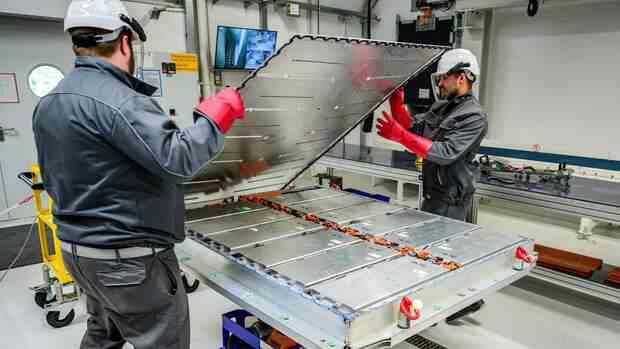In the coming years, many new production sites are to be built in Europe.
(Photo: AFP/Getty Images)
Brussels The demand for batteries will increase at an ever faster pace in the coming years, but the factories planned so far in Europe are keeping up with the development, says the environmental organization Transport & Environment (T&E).
The organization follows the announcements for battery factories in Europe and sums up the targeted production numbers. Accordingly, it is likely that lithium-ion batteries with a total capacity of 413 gigawatt hours (GWh) will be manufactured in Europe by 2027, with a further 203 GWh possible.
The list includes 29 projects within the EU, Norway and Great Britain, each of which should produce batteries with at least ten GWh per year. Seven of them are running in Germany.
If all of these projects are actually implemented, it would cover demand even if industrial policy measures continue to boost demand for batteries. Accordingly, both demand and production capacity will more than double in the next three years. It is possible that more will then have to be imported again: The supply is estimated at 773 to 1394 GWh for 2030, the demand at 1050 to 1240 GWh.
Top jobs of the day
Find the best jobs now and
be notified by email.
So far, only around half of the batteries used in European electric cars are manufactured within the EU, mainly in Poland and Hungary, and to a lesser extent in Germany and Sweden.
Climate activists call for subsidies for battery factories
The climate protectors from T&E are urging politicians to provide comprehensive subsidies so that the battery factories are actually built as announced. The number of investors in battery factories is limited, and the US is luring billions of dollars in tax credits under its Inflation Reduction Act (IRA). A car with an 80 KWh battery is subsidized at US$3600 in the US if the battery is US-made.
A debate has broken out in the EU about how this support can be countered and where the money should come from. EU state aid law sets strict limits on state subsidies. Relaxation of these rules is viewed critically by many countries that cannot afford subsidy programs.
>> Read here: Macron and Scholz want to speed up industrial policy in the EU
EU Council President Charles Michel is therefore calling for strategic investments to be subsidized at European level. The Sure program, which financed short-time work benefits in 19 EU countries during the corona crisis, should serve as a model. In an interview with the Handelsblatt, he also brought up a stronger role for the European Investment Bank (EIB).
Europe is becoming more independent when it comes to important raw materials
Environmentalists would like to go further and create a debt-financed EU fund for strategic investments. “A European sovereignty fund would enable a sustainable industrial strategy across Europe and not just in the financially strongest countries,” said Sebastian Bock, Director of T&E Germany. “However, the investment conditions for green technologies must be simplified so that the construction of a battery factory does not take as long as that of a coal-fired power plant.”
>> Read here: Michel’s four-point plan: This is what the European answer to the huge US subsidy program could look like
T&E also has hopes that Europe will slowly become more independent when it comes to battery materials. So far, lithium has mainly come from China and is also refined there. Factories for processing battery raw materials are also being built in Europe.
That would help to buy these raw materials from other countries. According to the report, two thirds of the European demand for cathodes – which contain the critical raw materials – could be produced in the EU by 2027.
More: Offshore boom in the USA – huge opportunity for German companies
